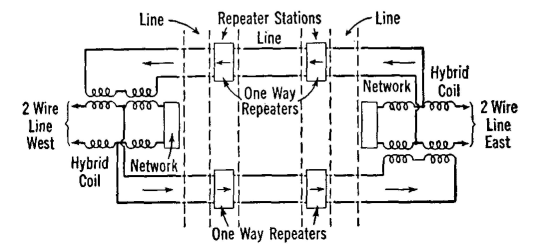| Electrical Communication is a free textbook on the basics of communication technology. See the editorial for more information.... |

|

Home  Telephone Toll Service and Systems Telephone Toll Service and Systems  Four-Wire Repeater Four-Wire Repeater |
|||






|
|||
Four-Wire RepeaterOften it is desirable to use four-wire circuits1,2,16 for telephone toll purposes. With this method, talking is in one direction over one pair of wires, and in the other direction over another pair. Such an arrangement is especially suited to toll cables; simpler repeaters can be used, and these can be operated at higher gains than with two-wire circuits, thereby necessitating fewer repeaters. Although twice as many cable wires are used, they may be smaller, and this fact, combined with the advantages of fewer and simple repeaters, often makes the four-wire circuit economical to use. A block diagram of the four-wire arrangement including four-wire 44-type repeaters is shown in Fig. 9. It will be noted that at each repeater point only one-way repeaters are required and that hybrid coils and balancing networks are not necessary. Hybrid coils and balancing networks reduce the four-wire circuit to a two-wire circuit at each end. Four-wire repeaters are worked at high gains, and thus the conductors transmitting in opposite directions must be separated as much as possible to prevent crosstalk between the high- and low-energy level cable pairs. Special cable arrangements and office wiring are used, and the circuits are segregated into the groups and separated.
|
|||
Home  Telephone Toll Service and Systems Telephone Toll Service and Systems  Four-Wire Repeater Four-Wire Repeater |
|||
Last Update: 2011-05-30


